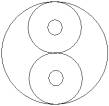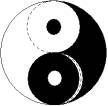 |
- the
(al)chemical vessel of the tree of life, abstracted from Anatomia Auri sive Tyrocinium Medico-Chymicum of J.D. Mylius
(Frankfurt, 1628) |
Meaning of the Logo
 | The basic
Yang-Yin diagram is here generalized recognizing that it basically consists of
two binding circles (spheres), meaning two binding atoms. Since the two spheres further embrace in another one they eventually will form a bond. Now, considering the two complementary “colours” black and white the actual meaning suggest that the bond is prescribed by the combined influences that black and white reciprocal and mixed arrangements induce. |
 |
The result is that from two spheres results another one, a bigger one as two atoms combines into a molecule. The bond is a subtle reality (a quantum one) assured by the complementarity of colours. The frontiers of atoms in molecule (recalling the atomic basin concept of Atoms-in-Molecule Theory) are now suggested by the persisted dashed line. By semiotic analysis, the metaphor says that the two binding circles may be looked as the symbol for infinitum while infinitum is contained by another circle thus saying in fact that “All is one!” In chemical language: all combinations in Nature have the same nature as the chemical bond prescribes in its inner quantum nature. The three time of nature corresponds with the three spheres virtually flourishing from the life tree within chemical vessel. Now, all these three parts (that can be seen also like bonding, anti-bonding and no-bonding aspects of a chemical bond) are unitarily liked outside the chemical vessel, in top of it, as a result of chemical reactions placed in it. |
| From atoms to molecule, from circles to infinitum, that was the inspired thought that given also the associated logos: “Injiciens Atomo Desideria Infinita”. This verse stands as the Latin (the alchemy language) translation (due to Traian Lăzărescu in 1980) of the verse “Endless bonding wishes are bonded within an atom” (in my adapted English translation) from the poem “Imperator et Proletarius” (in Romanian language) of the Romanian national poet Mihai Eminescu (1850-1889), the last romantic of Europe, following the line of Byron, Hugo, Hölderlin, Leopardi, Lermontov, Petöfi, and Mickiewicz, under the influence of Kant and Novalis. | |
 | However, this inspired logos was placed as an aurora of the previously symbolically described chemical processes of bonding so that to finally suggest, together with the chemical vessel part, another symbol of infinitum. Finally, this two meta-spheres of infinitum (the aerial stage of knowledge) stay on other sphere (the earthier stage of knowledge) waiting for being encompassed by this last one to completely unify the theoretical (celestial, imaginative, speculative, conceptual knowledge) with the practical (observed, measured, experimented, tested knowledge) nature of chemical life. |
This way, all physical and metaphysical, practical and conceptual aspects of CHEMICAL BOND AND BONDING can be wisely represented by this originally compiled logo and logos. Mihai V. Putz, Ph.D. Guest Editor of CHEMICAL BOND AND BONDING |